





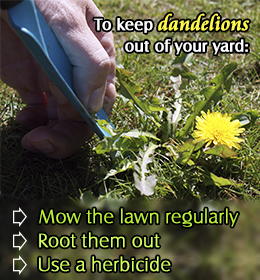 Did You Know?The English name, dandelion, is derived from the French name dent de lion meaning 'lion's tooth'. The coarsely toothed leaves of the plant must have been responsible for this name. However, some believe that these plants were given this name because they are deeply toothed (rooted).Dandelions belong to the genus Taraxacum and family Asteraceae. Although these plants are useful to us humans in various ways, they are mostly considered as weeds worldwide. For example, the species Taraxacum officinale is listed as a noxious weed. Dandelion, a broad leaf perennial, survives in any soil. It grows vigorously in full sunlight. Its lance-shaped leaves can be 3 to 12" long and 1/2 to 2-1/2" wide. They always grow in a basal rosette above the central taproot. The rosettes can produce several flowering stems simultaneously. Dandelions can be easily distinguished with the help of the yellow or orange flowers they produce. On maturity, these flowers dry and turn into spherical white puffballs. These seed heads are called 'blowballs' or 'clocks'. They contain light seeds that spread with the wind.
Did You Know?The English name, dandelion, is derived from the French name dent de lion meaning 'lion's tooth'. The coarsely toothed leaves of the plant must have been responsible for this name. However, some believe that these plants were given this name because they are deeply toothed (rooted).Dandelions belong to the genus Taraxacum and family Asteraceae. Although these plants are useful to us humans in various ways, they are mostly considered as weeds worldwide. For example, the species Taraxacum officinale is listed as a noxious weed. Dandelion, a broad leaf perennial, survives in any soil. It grows vigorously in full sunlight. Its lance-shaped leaves can be 3 to 12" long and 1/2 to 2-1/2" wide. They always grow in a basal rosette above the central taproot. The rosettes can produce several flowering stems simultaneously. Dandelions can be easily distinguished with the help of the yellow or orange flowers they produce. On maturity, these flowers dry and turn into spherical white puffballs. These seed heads are called 'blowballs' or 'clocks'. They contain light seeds that spread with the wind.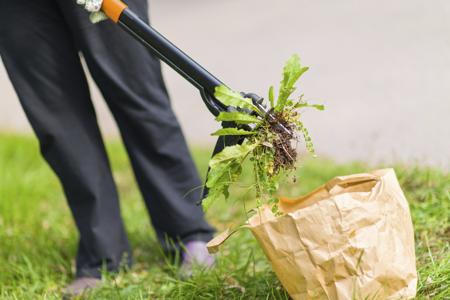 The best way to kill dandelion is to pull it out along with the taproot, which can be 2-3 feet deep in the soil. It is easy to pull the weed out if the soil is wet. Taproot is the main root of the plant which grows vertically downward from the stem. It is the supporting center root from which subsidiary branches emerge. Even though the plants are not seen in the fall, the taproots survive and continue to be there, deep in the soil. These roots are responsible for the growth of these plants in the spring. Therefore, to get rid of the noxious weed 'dandelion', it is necessary to kill its taproot. Hand-pulling might not help remove the complete taproot. You should use a long-handled dandelion puller, an auger bit screw, the Japanese weeder, or a foot pedal dandelion puller to pull out the root. You should use it in the spring, right when the first dandelion seedlings appear.Regular mowing
The best way to kill dandelion is to pull it out along with the taproot, which can be 2-3 feet deep in the soil. It is easy to pull the weed out if the soil is wet. Taproot is the main root of the plant which grows vertically downward from the stem. It is the supporting center root from which subsidiary branches emerge. Even though the plants are not seen in the fall, the taproots survive and continue to be there, deep in the soil. These roots are responsible for the growth of these plants in the spring. Therefore, to get rid of the noxious weed 'dandelion', it is necessary to kill its taproot. Hand-pulling might not help remove the complete taproot. You should use a long-handled dandelion puller, an auger bit screw, the Japanese weeder, or a foot pedal dandelion puller to pull out the root. You should use it in the spring, right when the first dandelion seedlings appear.Regular mowing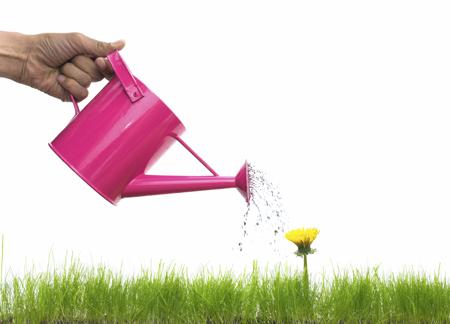 Regular mowing will help inhibit the growth of dandelions as soon as they emerge. As you know, flowers of dandelions get converted into white puffballs that contain seeds. The seeds are easily spread by the wind. Not allowing the weed to produce flowers helps to prevent it from spreading vigorously.Thickness and height of the lawnMow your grass a little bit taller (height can be 2.5 to 3 inches). Growing a thick, vigorous lawn helps control dandelion growth in your yard. Dense and a little taller grass deprives weeds from space and sunlight.Thus, by choking the seeds and depriving them of the necessary conditions for germination, you can curb the growth of the weed. If only a few dandelion plants are growing in your lawn, you can inhibit their growth by simply changing your maintenance tactics. Bare spots in the lawn should be immediately covered with sprigs of the grass that you want to maintain. Even a slightest opening in your lawn would help the fluffy and far floating seeds to propagate.Selective broadleaf herbicide
Regular mowing will help inhibit the growth of dandelions as soon as they emerge. As you know, flowers of dandelions get converted into white puffballs that contain seeds. The seeds are easily spread by the wind. Not allowing the weed to produce flowers helps to prevent it from spreading vigorously.Thickness and height of the lawnMow your grass a little bit taller (height can be 2.5 to 3 inches). Growing a thick, vigorous lawn helps control dandelion growth in your yard. Dense and a little taller grass deprives weeds from space and sunlight.Thus, by choking the seeds and depriving them of the necessary conditions for germination, you can curb the growth of the weed. If only a few dandelion plants are growing in your lawn, you can inhibit their growth by simply changing your maintenance tactics. Bare spots in the lawn should be immediately covered with sprigs of the grass that you want to maintain. Even a slightest opening in your lawn would help the fluffy and far floating seeds to propagate.Selective broadleaf herbicide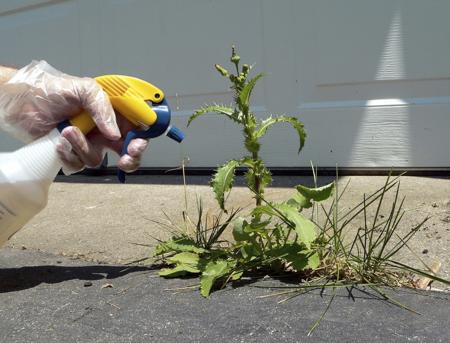 Since dandelion is a broadleaf weed, you need to apply a broadleaf herbicide to get rid of it. The herbicide won't kill your grass. You can apply Ortho Weed B Gon MAX plus Crabgrass Killer. It will kill dandelions without harming the lawn. Do not forget to feed your grass with Scotts Turf Builder. It will help your grass to grow and spread into the spots from where the dandelions have been dug out. Use synthetic herbicides only for chronic weed problems. Otherwise, use organic herbicides.Non-selective herbicideA non-selective herbicide, for example, glyphosate (Round-up) will not only kill the tenacious weed, but it will also kill the plants that come in contact with it. So, cover other plants with plastic or cardboard sheets properly before applying the herbicide. Non-selective herbicide can be used to kill dandelions growing in flower beds or walkways. It can be used to spot treat the weed. Both broadleaf or non-selective herbicides would not be effective once the dandelion plant starts producing flowers. You should apply them as soon as the plant emerges.Pre-emergent herbicideApplication of a pre-emergent herbicide in late winter can help prevent germination of dandelion seeds. It should be used before the seeds get a chance to germinate. It may affect the growth of the grass to some extent, but the grass would recover soon.Boiling water
Since dandelion is a broadleaf weed, you need to apply a broadleaf herbicide to get rid of it. The herbicide won't kill your grass. You can apply Ortho Weed B Gon MAX plus Crabgrass Killer. It will kill dandelions without harming the lawn. Do not forget to feed your grass with Scotts Turf Builder. It will help your grass to grow and spread into the spots from where the dandelions have been dug out. Use synthetic herbicides only for chronic weed problems. Otherwise, use organic herbicides.Non-selective herbicideA non-selective herbicide, for example, glyphosate (Round-up) will not only kill the tenacious weed, but it will also kill the plants that come in contact with it. So, cover other plants with plastic or cardboard sheets properly before applying the herbicide. Non-selective herbicide can be used to kill dandelions growing in flower beds or walkways. It can be used to spot treat the weed. Both broadleaf or non-selective herbicides would not be effective once the dandelion plant starts producing flowers. You should apply them as soon as the plant emerges.Pre-emergent herbicideApplication of a pre-emergent herbicide in late winter can help prevent germination of dandelion seeds. It should be used before the seeds get a chance to germinate. It may affect the growth of the grass to some extent, but the grass would recover soon.Boiling water Pour boiling water over dandelion plants. You may pour it 3-4 times during a day. The plants would wilt and die within a couple of days.Vinegar
Pour boiling water over dandelion plants. You may pour it 3-4 times during a day. The plants would wilt and die within a couple of days.Vinegar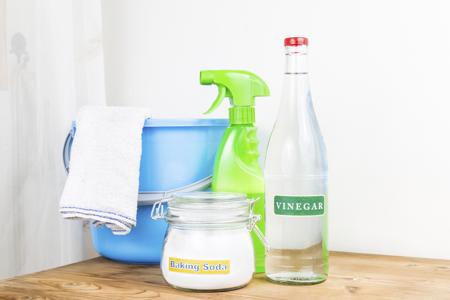 The acetic acid in vinegar helps kill the weed. Vinegar with higher amount of acetic acid can be used as a herbicide for the weed. By boiling the culinary vinegar, you can convert it into concentrated form. Apply it to the leaves of the weeds. You may pour some vinegar into the hole generated by dandelion removal. As vinegar is a non-selective herbicide, it may damage your grass to some extent.Muriatic acid
The acetic acid in vinegar helps kill the weed. Vinegar with higher amount of acetic acid can be used as a herbicide for the weed. By boiling the culinary vinegar, you can convert it into concentrated form. Apply it to the leaves of the weeds. You may pour some vinegar into the hole generated by dandelion removal. As vinegar is a non-selective herbicide, it may damage your grass to some extent.Muriatic acid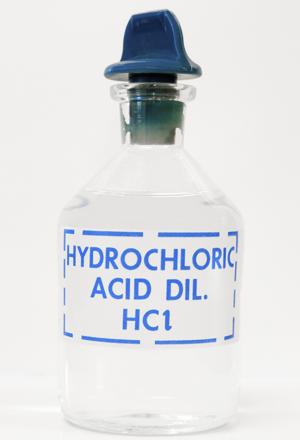 You may apply some muriatic acid on dandelion leaves. The leaves would turn brown and the plant would die soon.Mulch and compostAs dandelions tend to grow weaker in nutrient-rich soil, feeding the soil with nutrients helps eliminate the weed.Chickens or rabbits
You may apply some muriatic acid on dandelion leaves. The leaves would turn brown and the plant would die soon.Mulch and compostAs dandelions tend to grow weaker in nutrient-rich soil, feeding the soil with nutrients helps eliminate the weed.Chickens or rabbits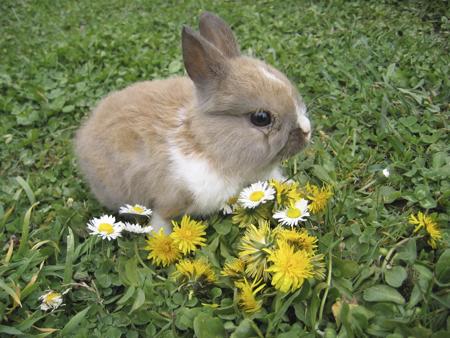 If you have chickens or rabbits, you can easily get rid of dandelions without killing your grass. These small animals love eating dandelions. They would eat them up as soon as they emerge.Table salt
If you have chickens or rabbits, you can easily get rid of dandelions without killing your grass. These small animals love eating dandelions. They would eat them up as soon as they emerge.Table salt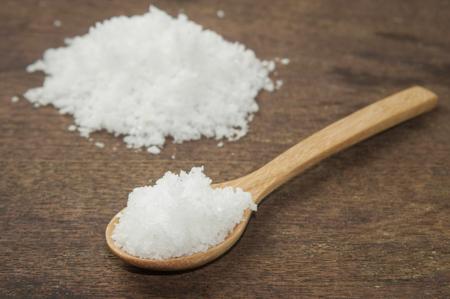 Put one tablespoon of salt at the base from where the plant emerges. This will help kill the weed. Use it carefully, the salt should not kill your favorite plants.Corn gluten mealThe yellowish powder of corn gluten meal (CGM) acts as a pre-emergent natural herbicide. It won't allow dandelion seeds to germinate. You should apply it 4-6 weeks before the weeds germinate.Weed burner torchIf nothing works, you can use a weed burner torch to kill the weed.You can use dandelion leaves in salads. They are packed with various nutrients. Although they taste slightly bitter, they help enhance the taste of the salad. You can use them raw, cooked, or sauteed. The yellow parts of the flowers are used to make wine. Flowers, when added to salads, add taste and color to the salad. Cooked dandelion roots can be added to soups. The roots, as a herbal medicine, are used to treat various conditions. The white, milky latex secreted by dandelions is also used to treat various skin conditions. It helps soothe the irritated skin. Thus, instead of throwing away the weed, you can use it in different ways.
Put one tablespoon of salt at the base from where the plant emerges. This will help kill the weed. Use it carefully, the salt should not kill your favorite plants.Corn gluten mealThe yellowish powder of corn gluten meal (CGM) acts as a pre-emergent natural herbicide. It won't allow dandelion seeds to germinate. You should apply it 4-6 weeks before the weeds germinate.Weed burner torchIf nothing works, you can use a weed burner torch to kill the weed.You can use dandelion leaves in salads. They are packed with various nutrients. Although they taste slightly bitter, they help enhance the taste of the salad. You can use them raw, cooked, or sauteed. The yellow parts of the flowers are used to make wine. Flowers, when added to salads, add taste and color to the salad. Cooked dandelion roots can be added to soups. The roots, as a herbal medicine, are used to treat various conditions. The white, milky latex secreted by dandelions is also used to treat various skin conditions. It helps soothe the irritated skin. Thus, instead of throwing away the weed, you can use it in different ways.Copyright © www.100flowers.win Botanic Garden All Rights Reserved